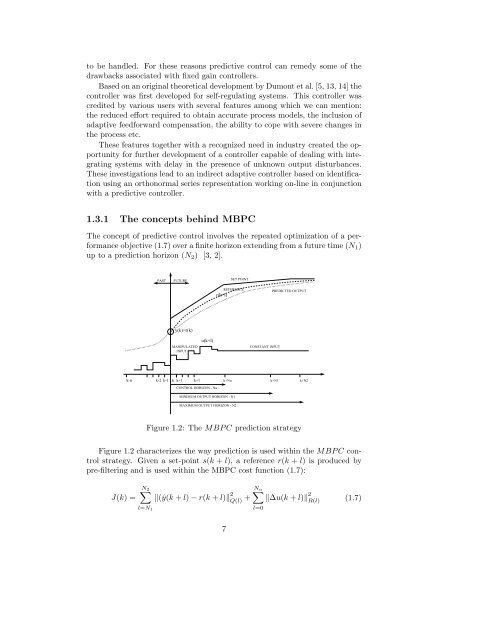Adaptive Predictive Regulatory Control with BrainWave - Courses ...
Adaptive Predictive Regulatory Control with BrainWave - Courses ...
Adaptive Predictive Regulatory Control with BrainWave - Courses ...
You also want an ePaper? Increase the reach of your titles
YUMPU automatically turns print PDFs into web optimized ePapers that Google loves.
to be handled. For these reasons predictive control can remedy some of the<br />
drawbacks associated <strong>with</strong> fixed gain controllers.<br />
Based on an original theoretical development by Dumont et al. [5, 13, 14] the<br />
controller was first developed for self-regulating systems. This controller was<br />
credited by various users <strong>with</strong> several features among which we can mention:<br />
the reduced effort required to obtain accurate process models, the inclusion of<br />
adaptive feedforward compensation, the ability to cope <strong>with</strong> severe changes in<br />
the process etc.<br />
These features together <strong>with</strong> a recognized need in industry created the opportunity<br />
for further development of a controller capable of dealing <strong>with</strong> integrating<br />
systems <strong>with</strong> delay in the presence of unknown output disturbances.<br />
These investigations lead to an indirect adaptive controller based on identification<br />
using an orthonormal series representation working on-line in conjunction<br />
<strong>with</strong> a predictive controller.<br />
1.3.1 The concepts behind MBPC<br />
The concept of predictive control involves the repeated optimization of a performance<br />
objective (1.7) over a finite horizon extending from a future time (N1)<br />
up to a prediction horizon (N2) [3, 2].<br />
PAST FUTURE<br />
y(k)=r(k)<br />
MANIPULATED<br />
INPUT<br />
k-n k-2 k-1 k k+1 k+l<br />
u(k+l)<br />
SET POINT<br />
REFERENCE<br />
r(k+l)<br />
CONTROL HORIZON - Nu<br />
MINIMUM OUTPUT HORIZON - N1<br />
MAXIMUM OUTPUT HORIZON - N2<br />
CONSTANT INPUT<br />
PREDICTED OUTPUT<br />
k+Nu k+N1 k+N2<br />
Figure 1.2: The MBPC prediction strategy<br />
Figure 1.2 characterizes the way prediction is used <strong>with</strong>in the MBPC control<br />
strategy. Given a set-point s(k + l), a reference r(k + l) is produced by<br />
pre-filtering and is used <strong>with</strong>in the MBPC cost function (1.7):<br />
J(k) =<br />
N2 <br />
l=N1<br />
<br />
(ˆy(k + l) − r(k + l) 2<br />
Q(l) +<br />
Nu<br />
7<br />
l=0<br />
∆u(k + l) 2<br />
R(l)<br />
(1.7)

















